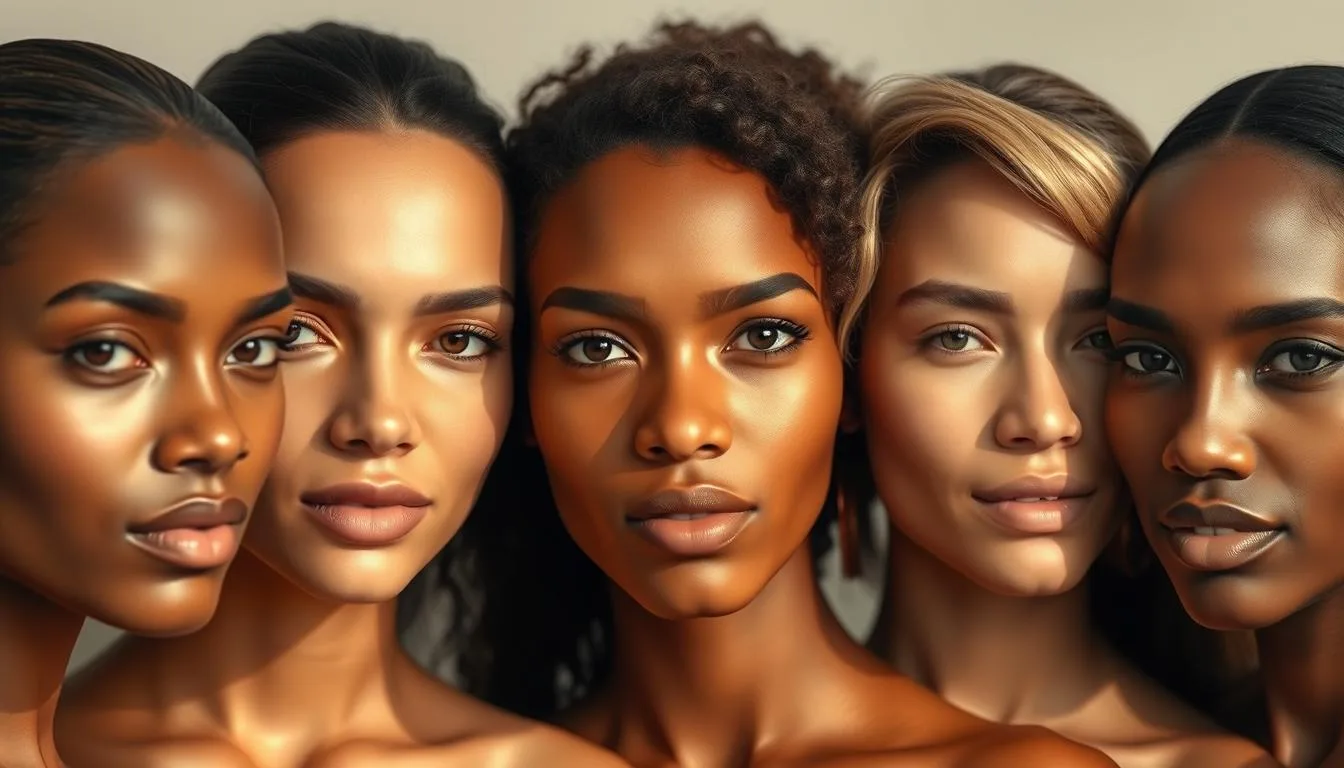Did you know that over 70% of people struggle to find the right foundation shade because they don’t know their skin undertone? Understanding your undertone is the key to unlocking a flawless makeup look that enhances your natural beauty.
Your undertone is the underlying hue of your skin, which can be cool, warm, or neutral. Unlike your skin tone, which refers to how light or dark your skin is, your undertone influences how colors look on you. For example, cool undertones often have a pinkish tint, while warm undertones lean towards yellow or golden.
Knowing your undertone is crucial for selecting makeup that complements your skin. Whether it’s foundation, blush, or eyeshadow, the right undertone ensures your makeup blends seamlessly and looks natural. If you’ve ever wondered why a shade looked great in the store but not at home, it might be because of a mismatched undertone.
Discovering your undertone is easier than you think. Simple tests, like checking the color of your veins or how jewelry looks on you, can give you clues. Warm undertones often look best in gold jewelry, while cool tones shine in silver. Neutral undertones can pull off both!
Ready to enhance your beauty routine? Learning your undertone is the first step to finding makeup that truly matches your unique skin. Keep reading to explore more about your personal undertone and how it can transform your look.
Key Takeaways
- Understanding your skin undertone is essential for perfect makeup matching.
- Undertones can be cool, warm, or neutral and differ from your skin tone.
- Cool undertones have pinkish hues, while warm undertones lean towards yellow or gold.
- Neutral undertones can complement both cool and warm color palettes.
- Simple tests like vein color and jewelry preferences can help determine your undertone.
Introduction: The Importance of Knowing Your Skin’s Undertone
Understanding your undertone is the first step to enhancing your beauty routine. Whether you’re choosing makeup or picking out clothes, knowing your undertone helps you make decisions that flatter your natural appearance.
Why Undertones Matter for Your Look
Your undertone acts as a guide for selecting shades that complement your natural hue. For instance, warm undertones look stunning in earthy tones like golden browns, while cool undertones shine in crisp pinks. Neutral undertones can pull off a wide range of colors, making them versatile.
Experts suggest looking at the color of your veins and jewelry preferences to hint at your undertone. If you look good in gold, you might have warm undertones. If silver makes you sparkle, cool undertones could be yours. This simple insight can transform your wardrobe and makeup choices.
A proper match between your tone and makeup prevents looking washed out. When your makeup complements your undertone, it blends seamlessly, creating a natural look. This understanding boosts confidence, helping you make informed choices that enhance your beauty.
- Knowing your undertone is key for flattering makeup and wardrobe choices.
- Warm tones shine in earthy shades, while cool tones excel in crisp colors.
- Veins and jewelry preferences offer hints about your undertone.
- Matching your makeup to your tone avoids a mismatched look.
- Understanding your undertone leads to more confident beauty decisions.
While guidelines are helpful, your personal style should always be your guide. Embrace your unique undertone and let it inspire your beauty choices.
Understanding Your Undertone Skin Color
Your undertone is the hidden hue beneath your skin’s surface, influencing how colors appear on you. Unlike your skin tone, which can change with factors like sun exposure, your undertone remains constant. It’s the key to selecting makeup and accessories that complement your natural beauty.
Different Types of Undertones
There are three main undertones: cool, warm, and neutral. Cool undertones have a pinkish tint, while warm undertones lean towards yellow or golden. Neutral undertones balance both, offering versatility in color choices.
Undertones vs. Skin Tone: Key Differences
- Skin tone refers to how light or dark your skin is, ranging from fair to deep.
- Undertone is the underlying hue that doesn’t change, influencing how colors look on you.
For example, if you look good in gold jewelry, you might have warm undertones. Silver often complements cool undertones. Neutral undertones can pull off both. This insight helps in choosing makeup that blends seamlessly, avoiding mismatched looks.
Common tests like checking vein color or jewelry preferences can help identify your undertone. Cool undertones often have blue or purple veins, while warm undertones may have greenish veins. Neutral undertones might have a mix, making it harder to distinguish.
Makeup products are labeled based on undertones—warm, cool, or neutral. Choosing the right label ensures your makeup enhances your natural look. For instance, warm undertones shine in golden browns, while cool undertones excel in crisp pinks. Neutral undertones can wear a wide range of colors, making them versatile.
Understanding your undertone is crucial for a flawless makeup look. It guides your choices in foundation, eyeshadow, and more, ensuring everything blends naturally. This knowledge boosts confidence, helping you make informed beauty decisions.
Simple At-Home Tests to Identify Your Undertone
Discovering your undertone doesn’t have to be complicated. With a few simple tests, you can determine whether you have cool, warm, or neutral undertones from the comfort of your home.
Vein Color Test Explained
Start by examining the veins on the inside of your wrist in natural light. If they appear blue or purple, you likely have cool undertones. Greenish veins suggest warm undertones, while a mix of colors indicates neutral undertones.
White Paper and Jewelry Methods
Next, try the white paper test. Hold a white sheet up to your face. If your skin looks pinkish, you have cool undertones. A yellowish tint means warm undertones. Neutral undertones will show a balanced appearance.
Jewelry can also provide clues. If silver makes your face glow, you likely have cool undertones. Gold complements warm undertones, and if both metals look good on you, you might have neutral undertones.
| Test | How to Do It | What It Indicates |
|---|---|---|
| Vein Color | Check wrist veins in natural light | Blue/Purple = Cool; Green = Warm; Mixed = Neutral |
| White Paper | Hold white paper against your face | Pinkish = Cool; Yellowish = Warm; Balanced = Neutral |
| Jewelry | Try on silver and gold | Silver = Cool; Gold = Warm; Both = Neutral |
Remember, natural light is key for accurate results. Repeat these tests at different times to confirm your undertone. Once you know your undertone, you can make informed choices about makeup and fashion that enhance your natural beauty.
Light, Sun Exposure, and Natural Setting Impacts
Natural light plays a crucial role in revealing your true hues. It provides the most accurate view of your skin undertone, helping you understand how colors appear on you. Unlike artificial light, which can distort, natural light shows your true look.
Utilizing Natural Light to See True Hues
Artificial lighting often alters how your skin appears, leading to incorrect assessments. For instance, warm lighting can make your skin look yellower, while cool lighting might give it a bluish tint. This distortion can affect how you perceive your undertone and hair color.
Sun exposure also impacts your look. Prolonged sun exposure can temporarily alter your skin tone, making it harder to determine your natural undertone. This is why testing your undertone in natural light is essential for accurate results.
To get the best results, test your undertone in various natural settings. Compare how your clothing and accessories look in daylight versus indirect sunlight. This will help you identify which colors complement you best.
Use these observations to make informed decisions about your hair color and wardrobe. Natural light will guide you in selecting clothing that enhances your appearance and ensures your hair looks its best.

Matching Your Foundation and Makeup with Your Undertone
Choosing the right foundation and makeup can transform your look, but it all starts with understanding your undertone. Whether you have cool, warm, or neutral undertones, selecting products that complement your natural hue ensures a seamless and flattering finish.
Choosing a Foundation That Works for You
Finding the perfect foundation involves more than just matching your skin tone. It’s about selecting a formula that aligns with your undertone. Cool undertones look best with foundations that have a pinkish tint, while warm undertones shine with yellow or golden hues. Neutral undertones can work with a variety of shades, but it’s important to test and find the one that blends naturally with your complexion.
Tips for Lipstick, Blush, and Eyeshadow
Once you’ve found your foundation, it’s time to enhance your look with other makeup essentials. For lipstick, cool undertones pair beautifully with crisp pinks and berry shades, while warm undertones look stunning in coral and golden tones. Neutral undertones can experiment with a wide range of colors for a versatile look.
Blush is another great way to accentuate your natural beauty. Cool undertones should opt for soft pinks or lavenders, while warm undertones can try peach or golden shades. Neutral undertones can pull off both cool and warm tones, making them versatile in their choices.
When it comes to eyeshadow, the same rules apply. Cool undertones should lean towards cool-toned eyeshadows like grays, blues, and purples. Warm undertones look best with earthy tones like browns, golds, and bronzes. Neutral undertones can mix and match to create a variety of looks.
| Undertone Type | Foundation Characteristics | Blush Recommendations | Eyeshadow Palette |
|---|---|---|---|
| Cool | Pinkish or blue undertones | Soft pinks, lavenders | Grays, blues, purples |
| Warm | Yellow or golden undertones | Peaches, corals | Browns, golds, bronzes |
| Neutral | Balanced, versatile | Both cool and warm shades | Mix of cool and warm tones |
Remember, the key to a flawless look is to keep it simple and natural. Let your undertone guide your choices, and don’t be afraid to experiment until you find what works best for you. With the right foundation and makeup, you’ll be on your way to a confident, radiant look that enhances your natural beauty.
Enhancing Your Look with Hair Color and Wardrobe Choices
Your hair color and wardrobe choices can greatly enhance your natural beauty when they align with your undertone. Whether you’re considering a new hairstyle or updating your closet, understanding how these elements work together can create a cohesive and flattering look.
How Hair Color Plays a Role
Hair color is a powerful tool for complementing your undertone. Cool undertones look stunning with ashy blondes or cool browns, while warm undertones shine with golden or honey hues. Neutral undertones can experiment with a variety of shades, from soft caramels to rich chocolates.
Natural light is essential for determining how your hair color interacts with your undertone. Test your hair color in different lighting conditions throughout the year to ensure it complements your skin. Seasonal changes might affect your visible skin tone, but your undertone remains constant, serving as a reliable guide for your style choices.
When coordinating your wardrobe, choose clothing that complements your hair color. For example, cool-toned individuals might opt for jewel tones like emerald or sapphire, while warm-toned individuals can embrace earthy shades like amber or caramel. Neutral tones like beige or soft grays are versatile and work well with most hair colors.

Remember, the key is to balance your hair color and wardrobe with your natural hues. By doing so, you’ll create a harmonious look that enhances your beauty and boosts your confidence.
Additional Methods for Determining Your Skin Undertone
Sometimes, figuring out your undertone on your own can be tricky. If home tests leave you unsure, it might be time to seek expert advice. Beauty professionals can offer personalized insights to help you determine your undertone accurately.
Consulting Beauty Experts for a Professional Insight
Professional color analysis is a detailed process where experts test various shades against your complexion to identify your undertone. They often use specialized tools and their trained eye to provide precise results. This method is especially helpful if you’ve tried home tests but are still uncertain.
Experts can also help you fine-tune your makeup and wardrobe choices. For example, they might recommend specific shades of blush or lipstick that complement your natural hue. If you’re considering a new hair color, they can suggest tones that will enhance your overall look.
| Method | Description | Benefit |
|---|---|---|
| Professional Color Analysis | Experts test shades against your complexion | Provides precise undertone identification |
| Personalized Recommendations | Custom advice for makeup and wardrobe | Helps you find flattering shades |
| Expert Guidance | Trained professionals offer tailored suggestions | Ensures a polished, cohesive look |
If home tests leave you confused, don’t hesitate to consult a professional. Their expertise can resolve mixed results and guide you to the perfect match for your unique features. With expert insights, you’ll enjoy a polished look that enhances your natural beauty.
Conclusion
Now that you’ve explored the world of undertones, it’s time to put this knowledge into action! Remember, understanding your undertone is more than just a beauty tip—it’s a powerful tool to enhance your natural beauty. Whether you have cool, warm, or neutral undertones, the right choices can make a world of difference.
Start by revisiting the simple tests, like the vein color or paper method, to confirm your undertone. Natural light is your best friend here, so take a moment to observe how colors look on you. If you’re still unsure, don’t hesitate to seek professional advice—it’s a small step that can lead to big changes in your beauty routine.
The benefits are clear: better makeup matching, a confidence boost, and a wardrobe that truly complements you. So, take this tip to heart and embrace your unique undertone. Your natural beauty is waiting to shine!
